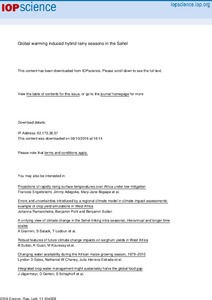| dc.contributor.author | Salack, S. |
| dc.contributor.author | Klein, C. |
| dc.contributor.author | Giannini, A. |
| dc.contributor.author | Sarr, B. |
| dc.contributor.author | Worou, O.N. |
| dc.contributor.author | Belko, N. |
| dc.contributor.author | Bliefernicht, J. |
| dc.contributor.author | Kunstman, H. |
| dc.date.accessioned | 2019-12-04T11:04:10Z |
| dc.date.available | 2019-12-04T11:04:10Z |
| dc.date.issued | 2016-10-05 |
| dc.identifier.citation | Salack, S., Klein, C., Giannini, A., Sarr, B., Worou, O.N., Belko, N., ... & Kunstman, H. (2016). Global warming induced hybrid rainy seasons in the Sahel. Environmental Research Letters, 11(10), 104008. |
| dc.identifier.issn | 1748-9326 |
| dc.identifier.uri | https://hdl.handle.net/20.500.12478/1359 |
| dc.description | Open Access Journal |
| dc.description.abstract | The small rainfall recovery observed over the Sahel, concomitant with a regional climate warming, conceals some drought features that exacerbate food security. The new rainfall features include false start and early cessation of rainy seasons, increased frequency of intense daily rainfall, increasing number of hot nights and warm days and a decreasing trend in diurnal temperature range. Here, we explain these mixed dry/wet seasonal rainfall features which are called hybrid rainy seasons by delving into observed data consensus on the reduction in rainfall amount, its spatial coverage, timing and erratic distribution of events, and other atmospheric variables crucial in agro-climatic monitoring and seasonal forecasting. Further composite investigations of seasonal droughts, oceans warming and the regional atmospheric circulation nexus reveal that the low-to-mid-level atmospheric winds pattern, often stationary relative to either strong or neutral El-Niño-Southern-Oscillations drought patterns, associates to basin warmings in the North Atlantic and the Mediterranean Sea to trigger hybrid rainy seasons in the Sahel. More challenging to rain-fed farming systems, our results suggest that these new rainfall conditions will most likely be sustained by global warming, reshaping thereby our understanding of food insecurity in this region. |
| dc.description.sponsorship | Federal Ministry for Education and Research, Germany |
| dc.format.extent | 1-11 |
| dc.language.iso | en |
| dc.subject | Global Warming |
| dc.subject | Farming Systems |
| dc.subject | Food Security |
| dc.subject | Agroclimatic |
| dc.title | Global warming induced hybrid rainy seasons in the Sahel |
| dc.type | Journal Article |
| dc.description.version | Peer Review |
| cg.contributor.crp | Climate Change, Agriculture and Food Security |
| cg.contributor.affiliation | Karlsruhe Institute of Technology |
| cg.contributor.affiliation | West African Science Service Center on Climate Change and Adapted Land Use |
| cg.contributor.affiliation | University of Augsburg |
| cg.contributor.affiliation | Columbia University |
| cg.contributor.affiliation | International Institute of Tropical Agriculture |
| cg.coverage.region | Africa |
| cg.coverage.region | East Africa |
| cg.coverage.region | West Africa |
| cg.coverage.country | Burkina Faso |
| cg.coverage.country | Ethiopia |
| cg.coverage.country | Niger |
| cg.coverage.country | Nigeria |
| cg.coverage.country | Senegal |
| cg.coverage.country | Sudan |
| cg.isijournal | ISI Journal |
| cg.authorship.types | CGIAR and developing country institute |
| cg.iitasubject | Climate Change |
| cg.journal | Environmental Research Letters |
| cg.howpublished | Formally Published |
| cg.accessibilitystatus | Open Access |
| local.dspaceid | 79455 |
| cg.targetaudience | Scientists |
| cg.identifier.doi | https://dx.doi.org/10.1088/1748-9326/11/10/104008 |

